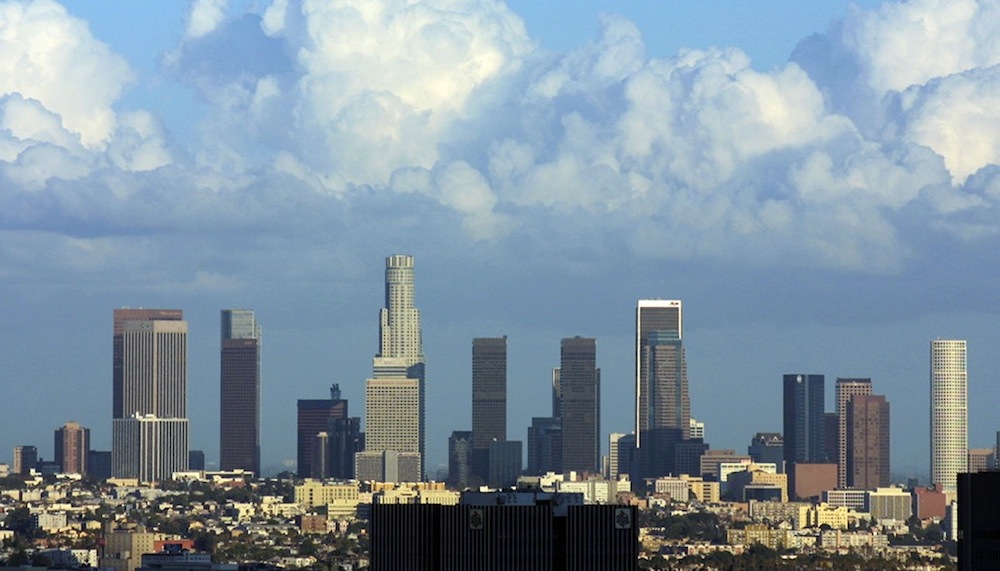Los Angeles reversed course last month on a regulation that had barred skyscrapers from having slanted roofs or spires. Most high-rises in the city have flat-topped roofs due to a decades-old rule meant to boost fire safety by requiring helicopter landing pads atop tall buildings.
The rule was unique among large cities in the U.S., according to city officials. New technology and design techniques have removed the need for such a rule, city officials say.
Architects had decried the old rule, saying it restricted creative building tops and prevented L.A. from having a distinctive skyline.
Under the new rule, builders will be able to construct high-rises that don’t have a helicopter pad on the roof if they include other safety features such as a fire service elevator or another set of exit stairs, automatic sprinklers, and a video surveillance system.
“Anyone who’s been to New York or cities like Shanghai, Hong Kong, and even San Francisco can see how the tops of building can help to define the identity of a city,” former City Councilman Mike Woo told the Los Angeles Times. “But for Los Angeles, for years, we have limited ourselves.”
(http://www.latimes.com/local/lanow/la-me-ln-skyscraper-flat-top-fire-rule-spires-20140929-story.html)
Related Stories
Legislation | Oct 10, 2022
Chicago’s updated building energy code provides incentives for smart HVAC, water appliances
The Chicago City Council recently passed the 2022 Chicago Energy Transformation Code that is intended to align with the city’s goal of reducing carbon emissions by 62% from 2017 levels by 2040.
Contractors | Oct 6, 2022
Modular construction gets boost from impacts of the pandemic
The impact of the Covid pandemic on the construction industry appears to be fueling demand for modular construction methods, especially in the western U.S. and Canada.
Fire and Life Safety | Oct 4, 2022
Fire safety considerations for cantilevered buildings
Bold cantilevered designs are prevalent today, as developers and architects strive to maximize space, views, and natural light in buildings. Cantilevered structures, however, present a host of challenges for building teams, according to José R. Rivera, PE, Associate Principal and Director of Plumbing and Fire Protection with Lilker.
Resiliency | Sep 30, 2022
Designing buildings for wildfire defensibility
Wold Architects and Engineers' Senior Planner Ryan Downs, AIA, talks about how to make structures and communities more fire-resistant.
| Sep 30, 2022
Lab-grown bricks offer potential low-carbon building material
A team of students at the University of Waterloo in Canada have developed a process to grow bricks using bacteria.
| Sep 27, 2022
New Buildings Institute released the Existing Building Decarbonization Code
New Buildings Institute (NBI) has released the Existing Building Decarbonization Code.
| Sep 22, 2022
Gainesville, Fla., ordinance requires Home Energy Score during rental inspections
The city of Gainesville, Florida was recently recognized by the U.S. Dept. of Energy for an adopted ordinance that requires rental housing to receive a Home Energy Score during rental inspections.
| Sep 19, 2022
New York City construction site inspections, enforcement found ‘inadequate’
A new report by the New York State Comptroller found that New York City construction site inspections and regulation enforcement need improvement.
| Sep 16, 2022
Fairfax County, Va., considers impactful code change to reduce flood risk
Fairfax County, Va., in the Washington, D.C., metro region is considering a major code change to reduce the risk from floods.
| Sep 13, 2022
California building codes now allow high-rise mass-timber buildings
California recently enacted new building codes that allow for high-rise mass-timber buildings to be constructed in the state.

















